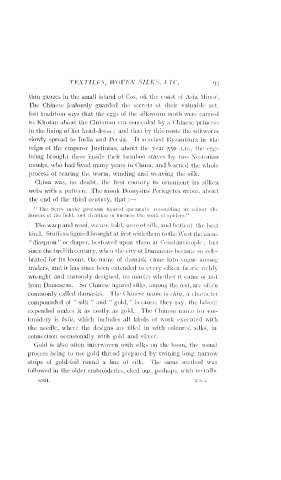Page 327 - Chinese Art, Vol II By Stephen W. Bushell
P. 327
TEXTILES, WOVEN SILKS, ETC.
93
thin gauzes in the small island of Cos, off the coast of Asia Minor.
The Chinese jealously guarded the secrets of their valuable art,
but tradition says that the eggs of the silkworm moth were carried
to Khotan about the Christian era concealed by a Chinese princess
in the lining of her head-dress ; and that by this route the silkworm
slowly spread to India and Persia. It reached Byzantium in the
reign of the emperor Justinian, about the year 550 a.d., the eggs
being brought there inside their bamboo staves by two Nestorian
monks, who had lived many years in China, and learned the whole
process of rearing the worm, winding and weaving the silk.
China was, no doubt, the first country to ornament its silken
webs with a pattern. The monk Dionysius Periegetes wrote, about
the end of the third century, that —
:
" The Seres make precious figured garments, resembling in colour
tlie
flowers of the field, and rivalling in fineness the work of spiders."
The warp and woof, we are told, were of silk, and both of the best
kind. Stuffs so figured brought at first with them to the West the name
"diaspron" or diaper, bestowed upon them at Constantinople; but
since the twelfth century, when the city of Damascus became so cele-
brated for its looms, the name of damask came into vogue among
traders, and it has since been extended to every silken fabric richly
wrought and curiously designed, no matter whether it came or not
from Damascus. So Chinese figured silks, among the rest, are often
commonly called damasks. The Chinese name is chin, a character
" silk " and "
compomided of gold," because, they say, the labour
expended makes it as costly as gold. The Chinese name for em-
broidery is hsitt, which includes all kinds of work executed with
the needle, where the designs are filled in with coloured silks, in
connection occasionally with gold and silver.
Gold is also often interwoven with silks on the loom, the usual
process being to use gold thread prepared by twining long narrow
strips of gold-foil round a line of silk. The same method was
.loUowed in the older embroideries, eked out, perhaps, with metallic
8941. 2 N 2

